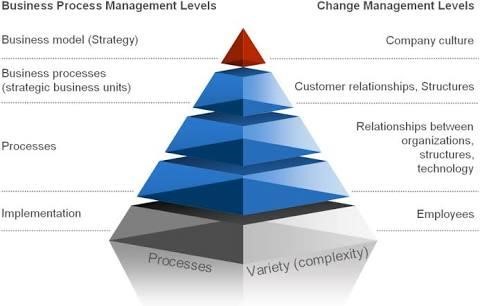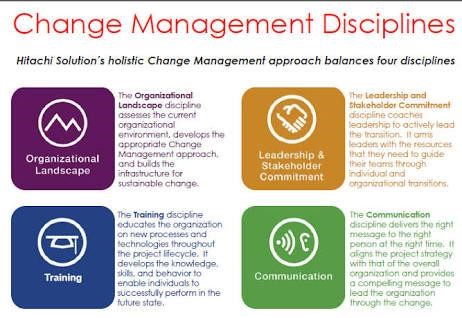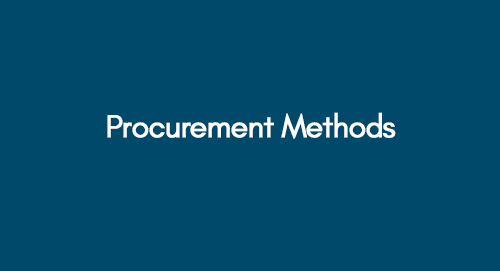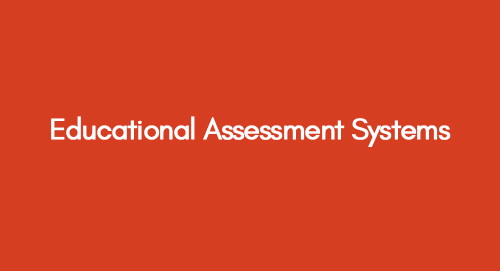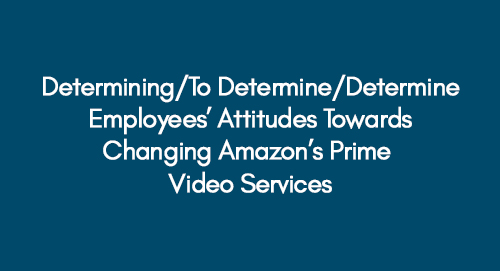
The Role of Relational Capital for Entrepreneurial Firms
December 20, 2020
Comparative Assessment of European and Chinese Civil Engineering Standards
December 20, 2020In a dynamic business environment, change is a constant and imperative factor. Organizations committed to maintaining a competitive edge and sustainable success actively seek effective ways to implement change, often leveraging technology and strategic growth initiatives.
The realization of the need for change stems from the understanding that businesses must adapt for profitability and long-term viability. Successful change implementation, aligned with well-defined goals, is crucial. Given the inherent resistance to change within the organizational culture and the increasing recognition of effective change management's importance, employing a structured framework is essential.
Learn More About Construction Management
Explore More About Construction Management
This report aims to highlight the core components of an effective change management framework and its pivotal role in achieving successful change implementation, ultimately fostering business growth and desired outcomes (Paton and McCalman, 2000). It further provides recommendations for Caledonian LLC, a mid-sized construction firm grappling with change management challenges in its project environment. The focus is on proposing a robust change management framework, particularly within their construction projects, integral to their business model, and addressing specific factors contributing to resistance at different organizational levels, including cultural, leadership, and power dynamics. As underscored by Salminen (2000), in today's dynamic business landscape, effective change management is essential for smooth and profitable business operations, highlighting the significance of adopting a highly effective change management process.
The Case of Caledonian LLC
To understand why Caledonian LLC is currently undergoing these changes, one must consider the complex dynamics inherent in construction projects. These dynamics often necessitate revisions to project parameters, including variations between the initial design and actual construction, conditional changes, material requirements, price fluctuations, and modifications in the Bill of Quantities (BOQ), among others. These variations can be effectively managed through change management, which is the focal point of this research. In some instances, they can be preempted through the adoption of efficient construction practices and optimized procurement and construction strategies.
Change management can be viewed as a structured, systematic process essential for facilitating the successful transition of processes, human resources, and other business components from their current state to a planned future state. This transition typically aligns with a high-level business strategy aimed at achieving a core objective or tactical goal. The overarching purpose of the framework is to inspire, motivate, and empower teams and individuals to embrace the intended change while recognizing the growth potential it holds. This often involves adapting management styles and defining leadership approaches to address resistance, motivate employees, foster a productive workplace culture, and reshape perspectives regarding the change.
According to the Change Management Leadership Guide (2011) by Ryerson University, the change management process is seen as a systematic approach that drives organizational change, stemming from various internal and external factors within the business environment. It serves as a transition facilitator, enabling employees to adopt new technology, processes, core values, strategies, and reporting hierarchies aligned with the revised business environment. This is particularly relevant in the context of adjusting contract and procurement strategies and effectively managing the risks associated with project variations in construction projects. In their literature "Global Trends in Managing Change," Lisa M. Kudray and Brian H. Kleiner (2015) emphasize that change management is a structured, ongoing approach that enables enterprises to align themselves efficiently with their business operations or market, ultimately gaining a competitive edge.
However, the question arises: What instigates change within project environments or organizations? Bendor-Samuel (2004) underscores the nature of business operations and the dynamics of the business environment, highlighting the imperative need for change. The primary objectives of change management include driving growth, expanding knowledge, fostering realization, enhancing productivity, inspiring individuals to embrace change, averting disputes, and developing employees by emphasizing their role in contributing to business success through change adoption. Change can broadly be categorized into two types: incremental change, involving continuous improvements and refinements in line with business evolution, and radical changes that bring about substantial and fundamental shifts in the overall business environment, elevating it to a higher level (Lanning, 2001, 10). Radical change often influences corporate culture and strategy, while incremental change fine-tunes existing business operations.
Causal Analysis
As previously discussed, understanding the drivers of organizational change and the reasons for resistance in project environments is essential for successful project management. An established change management framework is instrumental in addressing these factors. Common drivers for organizational change encompass both internal and external factors. Internally, organizations may need to transition to new technology to replace obsolete systems or services (e.g., leveraging BIM to enhance efficiency in construction projects), upgrade services or products (e.g., implementing cost estimation tools), refine business processes to enhance productivity and customer satisfaction (e.g., adapting procurement systems to align with client requirements), manage a growing and diverse workforce, or seize new market prospects and opportunities. External factors include competition, customer base, political and economic influences, regulations, and societal shifts (Lanning, 2001).
Effectively managing change necessitates management's assessment of the factors driving the desired change and the monitoring and direction of its implementation based on this evaluation. In organizations, the primary causes of resistance to change typically involve a lack of a clear vision, ineffective communication channels, and ill-defined roles and responsibilities. In construction project environments, changing attitudes, work behaviours, and perceptions among a diverse workforce often lead to resistance to change, which must be managed adeptly to ensure successful transformation (Paton and McCalman, 2000).
As a collaborative team striving toward organizational objectives, it is crucial that there's a shared acceptance of the change and an understanding of its implications regarding how work is conducted, how improvements can be made, and what actions are necessary. The purpose of change management is to ensure that the workforce perceives the change as an opportunity for personal and organizational growth. Therefore, systems should be designed to complement the change and encourage team contributions toward achieving change objectives.
Leadership roles should prioritize clear communication of change objectives to the teams and elucidate the need to move forward to embrace growth. Project managers must assess internal resistance factors, such as entrenched cultural beliefs, conflicting viewpoints, lack of trust and job security concerns, and general apprehensions and fears related to the change. Typical factors that hinder the successful implementation of change in project environments include the influence of power or authority in terms of roles and designations, a lack of management support, and an unclear understanding of job roles and organizational culture. All these elements can significantly impact how the change is implemented and how the workforce perceives it. Ineffective processes, outdated working methods, and a resource base lacking the necessary skills, knowledge, and behavioural traits can trigger change in any organization, and the tools for implementing change must be adopted to achieve business growth. However, as highlighted above, certain factors can impede the seamless adoption of change, and these must be addressed for successful change management (Salminen, 2000).
Types of Changes and Models
Organisations must undergo both types of change and should therefore be equipped with the essential tools, knowledge and strategy to manage the change accordingly. Pritchett and Pound (1996, pp. 23–7), however, classify change into three lucid:
- Transformational Change:
- Development Oriented Change
- Transition-related Change
Evaluating the dynamics of an organisation's internal and external business environment, various other factors like social relations, government and other political entities, conflicting perceptions, customers and other stakeholders, economic entities and the surrounding environment variables tend to contribute to organisational change in a construction project.
For an organisation such as Caledonian LLC, it is important to understand what factors contribute to change and how they will affect the organisation post-change implementation. For this purpose, it is important to adopt a framework for successfully managing change with the intent to steer and measure the change in terms of quantitative and qualitative metrics in accordance with defined targets to ensure success in project environments. (Nyman and Silen, 1995, 47)
Figure 1: Change Management Levels (G-static, 2015)
Researchers and practitioners design various theories and models for the most effective procedural flow for managing organisational Change. The typical change management framework would vary according to an organisation's strategy and business environment, but the foundational elements remain consistent. A productive framework would therefore have the potential to identify change requirements, evaluate the change relative to business operations, promote a collaborative culture, define roles and responsibilities for change execution, monitor and evaluate change implementation while influencing work behaviour and managing resistance and lastly, promote an environment to pass on best practices.
Pendlebury, Gouard and Meston (1998) define ten essential aspects of influencing behaviour and promoting a cooperative workplace environment to manage the change that effectively results in change success. These aspects have been linked with the case of Caledonian LLC as below;
- Clarifying the vision; optimisation of project planning (e.g. during tendering), accurate estimation of activities etc.
- Setting priorities or mobilising; identifying what strategies are best and mitigating the risk of change
- Driving smooth execution; expertise of team’s human resources during project activities
- Monitoring change implementation or delivering; developing quality leadership
- Influencing attitudes to promote participation; training, and development of resources
- Managing resistance and motivating workforce; leadership and teamwork coordination
- Managing the impact of the power; effective leadership utilisation
- Communicating effectively; collaborating with different project teams to ensure information is transferred effectively and at the right time for all construction projects undertaken by the company
Impact of Power, Leadership and Culture on Change
Managing change entails aptly tackling the impact of environmental variables such as power, leadership roles and organisational culture. The power exercised through authority positions in an organisational hierarchy often tends to oppose change or subdue the efforts of the people seeking growth through a change process. There needs to be an appropriate and rational application of power that encourages change and allows employee participation. This is usually observed in large-scale construction project environments where change is often masked through decisions made by authority figures. Employee empowerment should lead to a participatory contribution to effectively managing change. Employee empowerment enables informed decisions that encourage change and facilitate commitment towards the vision and change objective.
Leadership styles and Management's reaction toward employees' suggestions and opinions regarding the change are also significant. Adopting and accepting change by all relevant personnel in an organisation requires influencing perceptions and motivating employees to contribute to the change. Managers often face hurdles in managing resistance to implementing change due to a lack of an influential leadership role (Yin, 2003). An effective leader and management system would inspire the workforce to develop and grow through change implementation by adapting work behaviour and managerial style to enhance productivity and obtain a commitment from the diverse workforce to achieve the desired vision and implement the planned strategy. This reflects the management's prowess and competence in leading and driving successful change implementation.
Organisation Culture as per research conducted, has the most significant influence and impact on organisational change. The culture includes aspects related to workforce dynamics, work relations, personalities, perceptions, attitudes and technical skill sets. These factors influence and roles and responsibilities define the overall workplace culture. The culture will reflect how a change in an organisation is embraced and what impacts will originate post the change implementation. There is often resistance to change in a diversified culture because of differing perspectives and varying skills and responsibilities that tend to promote conflicting views. Productive workplace culture will tend to encourage the development of employees, inspiring them to harbour flexible and more informed opinions about business growth and relevant change. The culture would give the workforce opportunities to grow as professionals, enabling them to dedicate their potential to meeting change objectives aligned with business strategies. The management and organisational leadership should aim at managing change by encouraging and promoting a diverse culture that allows constructive growth.
Analysis/ Critical Review
The literary review allows for an expansion of the already highlighted aspects of change management through the definition of a vision leading to the successful implementation of the change to a point where best practices can be passed on to similar change situations. Lessons can be learnt from the implemented change process to refine the framework further to enhance the change management effectiveness. The literature provides a thorough understanding of the causes and reasons for undertaking change initiatives in an organisation that harbours various internal and external business environment factors (Yin, 2003).
However, it should address the common causes of change in dynamic project environments such as the IT and large construction project environments where customer-based changes to the project are frequent, directly impacting the scope, finances and schedule of these projects. Factors like customer acceptance criteria, lack of a defined change control procedure, the role of the change control board or steering committee and external variables like regulations and government policies pertaining to construction project environments need to be highlighted. There are often unforeseen changes that can occur in a project-based business environment, and the change management framework should cater to managing such unforeseen changes. This would require including procedural flows in the business operations that would recognise the change at an early stage and evaluate the impact against defined benchmarks moving on to facilitate the smooth execution of the change implementation. While managing change, organisations need to measure and assess the change throughout the process to ensure success in accordance with defined objectives (Salminen, 2000).
Recommendations to Caledonian LLC
In retrospect the discussion above, it is evident that an effective change management framework is essential in order to manage change successfully within an organisation. The Caledonian LLC organisation has been experiencing primarily a lack of defined processes to manage customer changes for construction projects. The most important task for them is to highlight the strategy to manage scope changes or other relevant changes to the project by establishing a clear vision, identifying how the change will impact the overall project's defined criteria and defining clear responsibilities during change evaluation. The change then needs to be monitored throughout its implementation for successful closure. To implement this, the organisation needs to formally establish a change control procedure or framework while keeping the following points or aspects during formulation:
- Dedicated and committed management or leadership development, such as employing a multi-cultural project group and employee empowerment.
- Allowing sufficient resources for change implementation
- Motivating and influencing people to change perception, trouble-shooting and risk mitigations. This may involve adopting systems such as ‘Kilmann’s conflict management styles.’
- Enabling a diverse and open culture.
The following aspects need to be considered by the organisation to successfully manage change.
- Use the latest computer-aided systems for enhanced productivity, effective combination, data transitions, cost estimations, risk measurements and mitigations. The use of BIM, for instance, can significantly reduce the disputes between teams such as the construction and design teams, enhance cost estimations, enable auto update of real-time data during the construction, help in generating accurate BOQs etc.
- Keeping the customers involved throughout the process and gaining formal acceptance at each project phase. Reflecting any risk of changes in the approved method of construction or procurement strategies; to reduce the impact of changes and balancing the risk associated with the change
- Signing on the scope and acceptance criteria with the customer for the scope and change implementation.
- Measuring change performance and implementing best practices in similar change scenarios.
These success factors will enable the organisation to better manage its change needs through an effective procedural flow that will ensure it achieves a competitive edge for business growth.
Chapter I- Introduction
As of recent global development trends, there has been a keen interest in pursuing infrastructure projects in Kuwait, with the pattern veering towards investing in the Build, Operate and Transfer (BOT) projects. This global interest has further seen an upward momentum following the recently amended BOT legislation by the Kuwait Government (Sohail Barkatali, 2014). The evolution of the financing of projects in Kuwait was a major milestone that was achieved after the closure of the Az-Zour North IWPP phase I project in early January, and the interest of global investors has sparked to new heights. The Kuwait government has revised the entire legal framework for BOT procurement of infrastructure projects in Kuwait in retrospect of the value this contracting is bringing to the projects and the economy at large. Following the amended BOT law, an increased number of contractors and bidders are now looking to maximise returns on upcoming opportunities and development initiatives as Kuwait has already undertaken some public-private partnership projects.
The history of the building, operating and transferring BOT projects dates back to 2002 when Kuwait first started using the BOT model to construct its Sulaibiya wastewater and reclamation project with a cost estimate of US$377 million. The Ministry of Public Works signed a 27-year concession for the investors and sponsors of the project to put together a 25-year debt that was regionally funded (Fahad Al-Azemi et al ., 2014). Hence, there was a keen interest in pursuing built environment projects focused on employing the EPC procurement method. However, this trend witnessed a change with the successful closure of the Az-Zour North IWPP phase I project, which propelled investors to pursue the BOT procurement method.
Sohail Barkatali (2014), in his article ‘The BOT Market Reopens, states that “The Az-Zour North IWPP phase I project was procured under a framework defined by two pieces of legislation. The BOT law was passed in 2008, and the IWPP law was enacted in 2010 and amended in 2012. For IWPP (independent water and power producer) projects, the IWPP law prevails over the BOT law. However, the BOT law applies when the IWPP law is silent on any matter. Therefore, Kuwaiti projects procured as public-private partnerships are undertaken within the framework established by the BOT law and, for certain projects, supplemented by additional legislation”. This supports the evidence for the growing feasibility of the Kuwait BOT market for undertaking infrastructure projects.
Problem statement / Rationale
With the ease and convenience of the BOT law, government consideration for further amendments in the law and the feasibility of the Kuwait market, it can be ascertained that the BOT procurement trends project a profitable upward curve (Fahad Al-Azemi, 2014). However, there are other risk categories to be considered when undertaking build-operate-transfer (BOT) infrastructure projects in Kuwait relevant to the construction industry and its environmental variables. It is important that these economic, social, political and technology-related risks be evaluated through a sophisticated evaluation framework to assess further the feasibility of the BOT procurement in Kuwait projects and how it provides value for money.
The Kuwait BOT projects and case studies relevant to pursuing infrastructure projects are appropriate to provide evidence for the research claim and hypotheses. Kuwait BOT projects will further need to be evaluated to analyse the feasibility of this form of procurement and its profitability scope and study potential risks that will directly impact such endeavours. The motivation for this research topic comes from the fact that BOT procurement has been a successful trend for construction projects across the globe, especially in the Middle East and Kuwait presents a market reflecting an economic boom. The research through literature review and other research methods would tend to investigate the hypothesis that BOT procurement does provide for money in Kuwait projects.
Research Aim and Objectives
The aim of this study is to evaluate the feasibility of the BOT procurement trend in Kuwait's infrastructure projects and provide evidence that the BOT projects in Kuwait do provide value for money. The aim also veers toward highlighting and evaluating the impact of specific risks involved in BOT projects, emphasising the Kuwait Construction Industry.
The primary objectives of the proposed study include:
- Evaluate different forms of project finance structures (such as BBFO, DBOT, BOT etc.) along with the most influential procurement systems (such as tradition, management etc.) utilised in the construction industry. Develop an understanding of these systems in terms of pros and cons, especially with reference to the delivery of large-scale and public-sector projects
- To review relevant literature related to the BOT initiatives in Kuwait focusing on the feasibility of such projects, develop an understanding of why this is so, and provide any statistical evidence through case studies to support the hypothesis.
- To review the BOT legislation and the Kuwait government's legal framework and evaluate the law's convenience and validity in pursuing BOT projects successfully.
- To evaluate through research techniques the profitability scope of BOT projects and how they can provide value for money to the investors.
- To evaluate the risks and limitations associated with BOT infrastructure projects in Kuwait and their particular impact on the project feasibility.
- To recommend strategic plans, risk management techniques and feasibility analysis of Kuwait BOT construction projects to prospective investors
Research Question
The Following research question provides a summary of the above aim and objectives:
Does the BOT procurement system deliver value-for-money projects in Kuwait?
The answer to the above research question will be explained through recommendations in the form of strategies found relevant and important in this research data analysis.
Chapter II- Literature Review
This section aims to highlight the analyses of key literature reviewed to obtain a deeper understanding of the trends relative to different finance systems along with the build-operate-transfer BOT projects in Kuwait, and the underlying risks relevant to the execution of such endeavours having a direct impact on the project feasibility. The study will thoroughly analyse procurement and finance systems utilised in the construction industry across the globe before focusing on Kuwait BOT projects being undertaken and their implications.
The private sector will significantly gain informative insight from the research as Kuwait has not yet experienced an influx of private finance for infrastructure projects. Still, with the advent of the BOT procurement method and the Kuwaiti legislation, the market will soon benefit from private investment for large development projects. The private sector will benefit as they have limited knowledge of the business environment in Kuwait relative to BOT projects. In contrast, the public sector will gain insight into the partnership framework and the feasibility aspects of investing in BOT projects. The evaluation and study of risks inherent in such projects will also be beneficial as effective risk management will increase the overall impact of the project, thus providing value for money.
Fahad Al-Azemi (2014), in his article, states, "According to Gunn (2005), the importance of risk management to the success of BOT projects cannot be overestimated. There are many different types of risk and uncertainty involved in every construction project, however small. These may be: technical, economic, legal, etc., but they all ultimately involve an organisation in financial risk. The risks pertaining to BOT projects are more complicated than the traditional methods, where the design is separate from the construction, and the client is responsible for the project. This is not only due to the long duration, high investment and complicated methods of procurement, but also because all of these risks are combined, with the companies involved in the project assuming responsibility for a whole range of risks within the life cycle of the project and the private sector taking responsibility for financial, design, construction and operating risks."
Hence, learning about the inherent risks is important to better mitigate them in successfully delivering BOT projects and enhancing their financial impact.
Chapter III-Methodology
The research method to be adopted in this research includes secondary data as well as primary data. Secondary data will be collected through a literature review and analysis of case studies, and quantitative as well as qualitative information related to the hypothesis of this research will be collected. The literature review will include journal articles, industry reports, business reviews and academic publications.
The secondary data will be collected through drafting surveys, questionnaires and interviews (primarily through sending drafted questionnaires via e-mail), which will be conducted to obtain the views of the current practitioners and stakeholders of the construction industry of Kuwait. This will be completed to collect supplementary information to further support the stance of recent developments, as well as to develop a deep understanding of the issues, visions, scope and views of the practitioners on the other finance as well as procurement strategies currently being utilised, and to gain an understanding of if they believe BOT is the future of Kuwait’s industrial future. The results of this research will be analysed in light of the secondary research completed (literature reviewed) and will then be used as a case study relevant to Kuwait infrastructure projects. For the BOT procurement analyses the following information will be particularly solicited.
- The demographics sample for each project such as industry, functional area and particular location in Kuwait.
- The method of procurement and contracting dynamics for infrastructure projects.
- Estimated cost and financial returns of the project at completion to highlight the financial impact of the project and its implications on the Kuwaiti economy.
- The particular impact of the BOT legislation on the development endeavours and its comparison with other forms of procurement.
- The effects and impact of business environment factors, including other political, social and technological aspects, on the feasibility of BOT projects.
- The specific risks relevant to each case and their impact on project feasibility.
- The investor's and other project stakeholders’ opinions about the feasibility of BOT projects in Kuwait and the value for money they reflect.
(More points will be added after undertaking a comprehensive review of the literature in this area of research)
Chapter IV- Research Findings and Discussion
This section highlights the detailed quantitative and qualitative results assimilated as a direct consequence of the primary research methodology and data evaluation techniques. Supported through analysis tools, the chapter will discuss the findings along with the comparative analysis relative to the reviewed literature.
Chapter V- Conclusions
This section highlights the recommendations and the deciphered conclusion based on the research query in retrospect of the analytical data collected and obtained through primary research practices. The chapter would further shed light on the future implications of the topic in question, emphasising the feasibility and prospective limitations from a future perspective.
References
Ackerman Anderson, L. and Anderson, D. 2001b. The Change Leader’s Roadmap: How to Navigate Your Organization’s Transformation. San Francisco: Jossey-Bass/Pfeiffer.
Adler, P.S. and Shenbar, A. 1990. Adapting Your Technological Base: The Organizational
Challenge. Sloan Management Review, Fall 1990, 25-37.
Alfa Annual Report, 2002. Helsinki: Edita Prima Oy. Beer, M. 1980. Organisation Change and Development: A Systems View. Santa Monica: Goodyear Publishing Company.
Boddy, D. and Buchanan, D. 1992. Take the Lead: Interpersonal Skills for Project Managers. Hemel Hempstead, UK: Prentice Hall.
Bridges, W. 1991. Managing Transitions: Making the Most of Change. Massachusetts: Addison-Wesley Publishing Company.
Bendor-Samuel, P. 2004. Change Management Tools Key to Winning Internal Acceptance: Implementing Offshore Strategies. Outsourcing Journal, March 2004. Everest Partners L.P. Referred: 10.3.2006. Available: <http://www.outsourcing-journal.com/mar2004-changemgmt.html/>
Change Management Levels, G-static 2015. Available at: < https://encrypted-tbn0.gstatic.com/images?q=tbn:ANd9GcS5lQmthv-Zunr_epDmoze29TPJlPNvCWPSEXZj7146F3425e4zXM-UO-fSRA/>. Accessed [29 November 2015]
Change Management Disciplines, G-static 2015. Available at: <https://encrypted-tbn0.gstatic.com/images?q=tbn:ANd9GcQTJEPBOxUWieD8g--bCnN3GfttYU-7_l-EsnEJMbg9-2dkkQWcHGWm8MBsxA/>. Accessed [29 November 2015]
Change Management Leadership Guide 2011, Human Resources, Organizational & Employee Effectiveness. Ryerson University.
Dalziel, M.M. and Schoonover, S.C. 1988. Changing Ways – A Practical Tool for Implementing
Change within Organizations. New York: American Management Association.
De Looff, L. 1997. Information Systems Outsourcing Decision Making: A Managerial Approach. Hershey, PA: Idea Group Publishing.
Fiebig, A. 1996. Outsourcing under the EC Merger Control Regulation. 17 European Competition Law Review 1996, 123-133.
French, W.L. and Bell, C.H. 1999. Organization Development - Behavioural Science Interventions for Organization Improvement. Sixth edition. Englewood Cliffs, NJ: Prentice Hall.
Gartner, 2003. Gartner Says Half of ESP Projects Will Be Considered Unsuccessful for Not Delivering Anticipated Value. Outsourcing Strategies and Challenges Discussed at Gartner Symposium/Expo 2003 in San Diego. Press Release 24.3.2003. Gartner Inc. Referred: 18.11.2005. Available: <http://www.gartner.com/press_releases/pr24mar2003b.html/>
Gartner, 2004a. Gartner's people3 Says Most IT Leaders Implementing Organization Changes Fail to Adequately Consider Their Company's Ability to Transform. Press release 6.12.2004. Gartner Inc. Referred: 18.11.2005. Available:<http://www.gartner.com/press_releases/asset_115496_11.html/>
Paton, R. and McCalman, J. 2000. Change Management: A guide to effective implementation. Second edition. London: SAGE Publications.
Pendlebury, J., Grouard, B. and Meston, F. 1998. The Ten Keys to Successful Change Management. West Sussex: John Wiley and Sons.
Salminen, A. 2000. Implementing Organizational and Operational Change – Critical Success Factors of Change Management. Helsinki University of Technology. Executive School of Industrial Management. Doctoral Dissertation.
Stake, R. E. 1995. The Art of Case Study Research. Thousand Oaks, CA: SAGE Publications.
St-Amour, D. 2001. Successful Organizational Change: Effective Management of People and Cultural Issues. Canadian Manager. Summer 2001, 20-22.
Uusitalo, Hannu 1991. Tiede, tutkimus ja tutkielma – Johdatus tutkielman maailmaan. Juva: WSOY.
We Know Where We’re Going…But What’s the Best Route, 2002. Alfa Group’s Staff magazine was Okay, 14.3.2002.
Yin, Robert 2003. Case Study Research – Design and Methods, Third Edition. Thousand Oaks, CA: SAGE Publications.
Ahmed, F.M.S.; Miroslaw, J.S.; Ismail, B. 2007. BOT viability models for large scale infrastructure projects, Journal of Construction Engineering and Management ASCE 133(1): 50–63.
Alduaij Osama Ibrahim. 2010. Arab Time Newspaper. Askar, M.; Gab-Allah, A. 2002. Problems Facing Parties Involved in Build, Operate, and Transfer projects in Egyp
Barkatali, Sohail. 2014, Kuwait: The BOT Market Reopens -- Az-Zour North IWPP, PPP Projects, Chadbourne 2015. Available at: <http://www.chadbourne.com/Kuwait_BOT_Market_projectfinance/> Accessed [27 November 2015]
Delmon, J. 2000. BOO/BOT projects: A commercial and contractual guide, Sweet & Maxwell Limited, London, 1: 40–62.
Dey, P.K.; Ogulana, S.O. 2004. Selection and application of risk management tools and techniques for Build-operate-transfer Projects, Industrial Management and Data Systems 104(4): 334–346.
Fahad Al-Azemi, Khalid, Ran Bhamra, and Ahmed FM Salman. "Risk management framework for build, operate and transfer (BOT) projects in Kuwait." Journal of Civil Engineering and Management 20.3 (2014): 415-433.
Journal of Management in Engineering 18: 173–178. Baloi, D.; Price, A.D.F. 2003. Modelling global risk factors affecting construction cost performance, International
Journal of Project Management 21: 261–269. Cheung, E.; Chan, A. P. C.; Kajewski, S. 2010.The public sector's perspective on procuring public works projects ‐comparing the views of practitioners in Hong Kong and Australia, Journal of Civil Engineering and Management 16(1): 19–32.
Tiong, R.L.K. 1990. Comparative study of BOT projects, Journal of Management in Engineering, ASCE, January, 6: 107-122.
Tiong, R.L.K. 1995a. Risks and guarantees in BOT tender, Journal of Construction Engineering and Management, ASCE, June, 183–188.
Tiong, R.L.K. 1995b. Competitive advantage of equity of BOT tender, Journal of Construction Engineering and Management, ASCE, Sept., 282–289.
Tiong, R.L.K. 1995c. Impact of financial package versus technical solution in BOT tenders, Journal of Construction Engineering and Management, ASCE, Sept, 304–311.
Tiong, R.L.K. 1996. CSFs in competitive tendering and negotiation model for BOT projects, Journal of Construction Engineering and Management, ASCE, Sept, 202–211.
Tiong, R.L.K.; Alum, J. 1997. Final negotiation in competitive BOT tender, Journal of Construction Engineering and Management, ASCE 6–10.
Tiong, R.L.K.; Yeo, K.M.; McCarthy, S.C. 1992. Critical success factors in winning BOT contracts, Journal of Construction Engineering and Management, ASCE, June, 217–228.
United Nations Industrial Development Organisation UNIDO 1996. Guidelines for Infrastructure Development through Build-Operate-Transfer (BOT) Projects, Vienna
Get 3+ Free Dissertation Topics within 24 hours?








